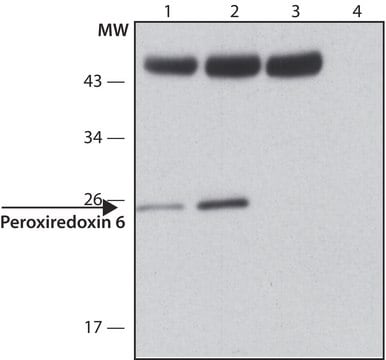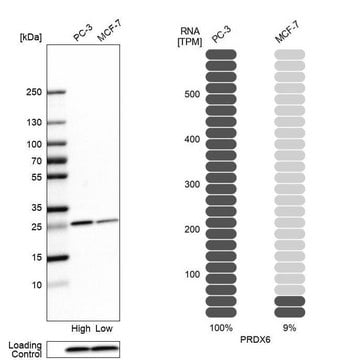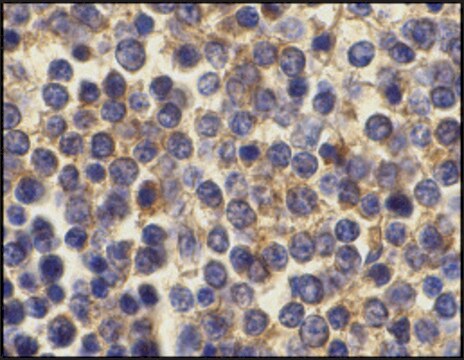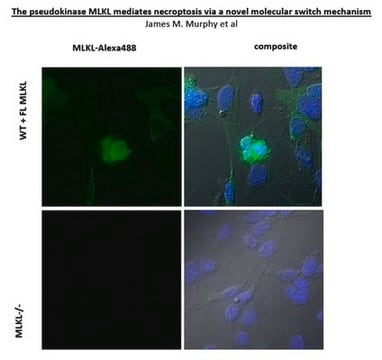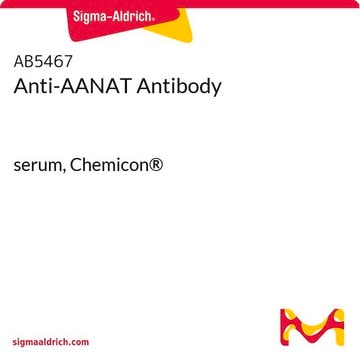MABN1797
Anti-Prdx-6 Antibody, clone TAG-2A12
clone TAG-2A12, from mouse
Synonim(y):
Peroxiredoxin-6, EC: 1.11.1.15, 1-Cys peroxiredoxin, 1-Cys PRX, 24 kDa protein, Acidic calcium-independent phospholipase A2, aiPLA2, Antioxidant protein 2, Liver 2D page spot 40, Non-selenium glutathione peroxidase, NSGPx
About This Item
Polecane produkty
pochodzenie biologiczne
mouse
Poziom jakości
forma przeciwciała
purified immunoglobulin
rodzaj przeciwciała
primary antibodies
klon
TAG-2A12, monoclonal
reaktywność gatunkowa
human
opakowanie
antibody small pack of 25 μg
metody
flow cytometry: suitable
immunocytochemistry: suitable
immunofluorescence: suitable
immunoprecipitation (IP): suitable
western blot: suitable
izotyp
IgG1κ
numer dostępu NCBI
numer dostępu UniProt
Warunki transportu
ambient
docelowa modyfikacja potranslacyjna
unmodified
informacje o genach
human ... PRDX6(9588)
Opis ogólny
Specyficzność
Immunogen
Zastosowanie
Immunocytochemistry Analysis: A representative lot detected Prdx-6 in Immunocytochemistry applications (Ding, V., et al. (2014). MAbs. 6(6):1439-52).
Flow Cytometry Analysis: A representative lot detected Prdx-6 in Flow Cytometry applications (Ding, V., et al. (2014). MAbs. 6(6):1439-52).
Immunofluorescence Analysis: A representative lot detected Prdx-6 in Immunofluorescence applications (Ding, V., et al. (2014). MAbs. 6(6):1439-52).
Western Blotting Analysis: A representative lot detected Prdx-6 in Western Blotting applications (Ding, V., et al. (2014). MAbs. 6(6):1439-52).
Flow Cytometry Analysis: A representative lot detected Prdx-6 in human corneal endothelial cells from a donor. (Courtesy of Dr. Vanessa Ding, Ph.D. and Dr. Andre Choo, Ph.D, BTI, Singapore).
Neuroscience
Jakość
Isotyping Analysis: The identity of this monoclonal antibody is confirmed by isotyping test to be human IgG1 .
Opis wartości docelowych
Postać fizyczna
Przechowywanie i stabilność
Inne uwagi
Oświadczenie o zrzeczeniu się odpowiedzialności
Nie możesz znaleźć właściwego produktu?
Wypróbuj nasz Narzędzie selektora produktów.
Kod klasy składowania
12 - Non Combustible Liquids
Klasa zagrożenia wodnego (WGK)
WGK 1
Certyfikaty analizy (CoA)
Poszukaj Certyfikaty analizy (CoA), wpisując numer partii/serii produktów. Numery serii i partii można znaleźć na etykiecie produktu po słowach „seria” lub „partia”.
Masz już ten produkt?
Dokumenty związane z niedawno zakupionymi produktami zostały zamieszczone w Bibliotece dokumentów.
Nasz zespół naukowców ma doświadczenie we wszystkich obszarach badań, w tym w naukach przyrodniczych, materiałoznawstwie, syntezie chemicznej, chromatografii, analityce i wielu innych dziedzinach.
Skontaktuj się z zespołem ds. pomocy technicznej